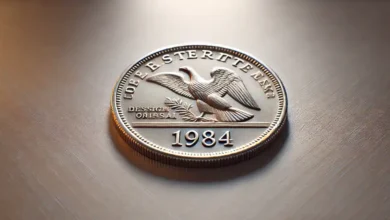Exploring the 1 Dollar Coin Australia: History, Design, and Collectibility

The 1 Dollar Coin Australia is an iconic part of the country’s currency system, valued for its practical use and role in national identity. Introduced in 1984, the coin marked Australia’s shift from paper currency to a more durable form for everyday transactions. From its iconic kangaroo design to its historical and cultural significance, the 1 Dollar Coin Australia reflects the nation’s spirit. It has a unique place in the world of collectors and currency enthusiasts.
Historical Background
The introduction of the 1 dollar coin in Australia came as part of a broader shift towards using coins for smaller denominations, reducing reliance on paper notes. In the early 1980s, Australia faced challenges with the lifespan and durability of its 1 dollar note, which required frequent replacements due to wear and tear. To address these issues, the Royal Australian Mint introduced the 1 dollar coin in 1984, designed to save costs and ensure a longer-lasting currency for public use.
The decision to switch from a note to a coin was not taken lightly. Australians were accustomed to the paper 1 dollar note, which featured intricate designs and symbols of the country’s heritage. However, as inflation and economic considerations mounted, the coin proved to be a practical solution. Unlike the note, which had a limited lifespan, the metal coin could withstand years of circulation, making it a sound investment for the country’s economy.
Design and Symbolism
The design of the 1 Dollar Coin Australia coin is one of its most defining features. The Royal Australian Mint commissioned Stuart Devlin, a renowned Australian artist, and designer, to create the coin’s appearance. Devlin depicted five kangaroos on the reverse side of the coin, a symbol synonymous with Australia’s wildlife and national identity. This choice of imagery resonated deeply with the Australian public, as kangaroos are not only native to Australia but also widely recognized worldwide as an emblem of the country.
The obverse side of the coin features a profile of the reigning British monarch. Until 2022, this was Queen Elizabeth II, whose likeness appeared on coins in Australia for decades. Including the Queen on one side and kangaroos on the other reflects Australia’s cultural ties to its native heritage and its historical connection to the British Commonwealth.
The kangaroo design has remained unchanged since the coin’s introduction, symbolizing stability and continuity in Australian currency. While the Royal Australian Mint has released various commemorative 1 dollar coins Australia with different designs, the kangaroo remains the enduring image on the standard coin, a tribute to its status as a national icon.
Physical Characteristics of the 1 Dollar Coin Australia
The 1 Dollar Coin Australia is easily recognizable due to its color and size. Made from an aluminum-bronze alloy, the coin has a composition of 92% copper, 6% aluminum, and 2% nickel, giving it a gold-like appearance that stands out from other coins in Australian currency.
In terms of size, the coin measures 25 millimeters in diameter and weighs approximately 9 grams. Its thickness and weight are carefully calibrated to distinguish it from other coins, ensuring ease of use in everyday transactions. These physical characteristics make the 1 Dollar Coin Australia durable and practical, able to withstand the rigors of circulation while maintaining its appearance over time.
The Coin’s Cultural and Economic Significance
Beyond its practical use, the 1 Dollar Coin Australia holds significant cultural value. Its introduction marked a shift in how Australians interacted with currency, moving from paper notes to a more robust form of money. The kangaroo design further cemented its status as an emblem of national pride, as it symbolizes Australia’s rugged landscape and unique wildlife.
Economically, the coin has played an essential role in the Australian monetary system. Its durability has reduced frequent replacements, saving government costs and contributing to a more sustainable economy. Additionally, the coin’s recognizable design and symbolism have made it a popular choice among tourists and collectors, adding to its economic impact beyond its face value.
Commemorative and Special Edition 1 dollar coins Australia
Over the years, the Royal Australian Mint has issued several commemorative versions of the 1 Dollar Coin Australia, each with a unique design celebrating various aspects of Australian culture, history, and achievements. These limited-edition coins often feature designs that honor significant national events, influential figures, or cultural milestones, providing collectors unique opportunities to own pieces of Australian history.
Notable commemorative coins include editions celebrating the centenary of the Australian Federation, the International Year of Indigenous Languages, and various anniversaries of Australian involvement in military conflicts. These coins are often released in limited quantities, which increases their value and appeal among collectors. Some designs are so rare that they fetch significant prices in the collectors’ market, far exceeding their face value.
The release of these commemorative coins has broadened the appeal of the 1 Dollar Coin Australia, making it a sought-after item for numismatists worldwide. Each commemorative design tells a unique story, offering a glimpse into different facets of Australian culture and history while retaining the core characteristics of the standard 1 dollar coin.
Collectibility and Value
The 1 Dollar Coin Australia offers a world of possibilities for coin collectors. While the standard circulation coin holds face value, specific editions and commemorative releases can be worth significantly more, depending on their rarity and condition. Collectors often seek out coins with unique characteristics, such as limited mintage, special designs, or errors in production, all of which can enhance a coin’s value.
Several factors influence the collectibility of 1 dollar coins Australia, including:
- Rarity: Coins issued in limited numbers are more valuable due to scarcity.
- Condition: Coins in pristine, uncirculated condition often fetch higher prices.
- Special Editions: Collectors particularly prize commemorative coins celebrating national events or featuring unique designs.
For those interested in starting a coin collection, the 1 Dollar Coin Australia offers an accessible entry point, with ample opportunities to explore both standard and rare editions. Collectors should watch for coins with unique markings or limited editions, as these can increase in value over time.
Manufacturing and Production Process of the 1 Dollar Coin Australia
The production of Australia’s 1 dollar coin is a meticulous process managed by the Royal Australian Mint in Canberra, a facility renowned for its high standards in quality and craftsmanship. Each coin’s journey from raw material to finished currency involves precise steps that ensure durability, aesthetic appeal, and, increasingly, environmental responsibility.
1. Material Selection and Alloy Preparation
The 1 Dollar Coin Australia is crafted from an aluminum-bronze alloy composed of 92% copper, 6% aluminum, and 2% nickel. This alloy is durable and lends the coin its distinctive golden color, making it stand out from other denominations in circulation. Sourcing and preparing this alloy is a critical first step, as it must meet stringent quality requirements. The alloy is selected for its resilience to wear and corrosion, ensuring each coin can withstand years of handling without significant appearance or structural integrity degradation.
2. Blanking Process: Creating the Coin Blanks
Once the alloy is prepared, it is rolled into sheets of a specified thickness. The next step is “blanking,” where round coin blanks are punched out of these metal sheets. These blanks are the unmarked, circular pieces that will eventually become coins. Each blank is cut to precise dimensions to ensure uniformity in weight and size, as these qualities are essential for the coin to function reliably in transactions and vending machines. The Royal Australian Mint uses advanced machinery to carry out this step efficiently and with minimal waste.
3. Annealing and Cleaning the Blanks
After blanking, the coin blanks undergo an annealing process, which is heated to a specific temperature and then slowly cooled. This step softens the metal, making it more malleable and better suited for the upcoming striking process. Following annealing, the blanks are washed and polished to remove any surface impurities or residues that may have accumulated during cutting or heating. This cleaning process is crucial, as it ensures a smooth surface on which the intricate coin designs can be clearly stamped.
4. Striking the Coin Design
With the blanks prepared, the next phase is the striking process, where each blank is stamped with the design of the 1 Dollar Coin Australia. The Royal Australian Mint uses specialized coin dies that bear the images of the kangaroos on one side and the reigning monarch (up until 2022, Queen Elizabeth II) on the other. The striking process involves immense pressure, typically up to 60 tons, which is applied to transfer the design from the dies onto the blank’s surface. This pressure embeds the fine details of the design, giving the coin its distinctive and intricate appearance.
5. Quality Control and Inspection
Following the striking process, each coin is rigorously inspected for quality. This inspection includes automated and manual checks to ensure that the coin meets the Royal Australian Mint’s high appearance, weight, and size standards. Coins that do not meet these standards, whether due to imperfections in the striking process or surface defects, are removed from the production line and recycled. This commitment to quality control ensures that only the highest quality coins enter circulation, maintaining public confidence in Australian currency.
6. Environmental Responsibility and Recycling Initiatives
The Royal Australian Mint has significantly aligned its operations with environmentally responsible practices. This includes recycling scrap metal generated during blanking and reusing materials whenever possible. By implementing recycling initiatives within the production cycle, the Mint minimizes waste and reduces the environmental footprint associated with coin manufacturing. Additionally, the Mint continuously explores new technologies and practices to reduce energy consumption and support sustainable production methods.
The Final Product: A Durable and Iconic Currency
Upon passing the quality inspection, the 1 dollar coins are counted, packaged, and prepared for distribution throughout Australia. Each coin, crafted with precision and care, is built to withstand the test of time, allowing Australians to handle and use it confidently for years. The Royal Australian Mint’s dedication to quality, efficiency, and sustainability ensures that the 1 Dollar Coin Australia remains a reliable and iconic part of the nation’s currency system.
In conclusion, the manufacturing and production of the 1 Dollar Coin Australia exemplify a blend of traditional craftsmanship and modern sustainability efforts. From raw material selection to the final inspection, every step in the process reflects the Royal Australian Mint’s commitment to excellence, making the 1 dollar coin a medium of exchange, a piece of art, and a symbol of national pride.
Interesting Facts and Lesser-Known Trivia
The 1 Dollar Coin Australia has accumulated a range of interesting facts and trivia over the years. Here are a few lesser-known aspects:
- Misprints and Errors: Some rare editions of the 1 dollar coin feature misprints or errors, such as doubling or off-center strikes. Collectors seek after these coins.
- Role in International Circulation: 1 Dollar Coin Australia has inspired coin designs in other countries due to its practicality and durability.
- Inflation and Value: While the coin holds face value, the impact of inflation over the years has affected its purchasing power. However, it remains a staple in Australian currency.
These fascinating tidbits add depth to the story of the 1 dollar coin, showcasing its evolution and impact beyond simple transactions.
Conclusion: The Legacy of the 1 Dollar Coin Australia
The 1 Dollar Coin Australia stands as a testament to the country’s unique heritage and practical ingenuity. Its design, durability, and symbolic imagery have made it an enduring part of Australia’s monetary system, bridging the past and the present in a simple yet powerful way. For everyday Australians, it represents convenience and tradition, while for collectors, it offers a window into the country’s cultural narrative.
As Australia continues to evolve, the 1 dollar coin remains a constant, reflecting the nation’s values and identity. Whether in a wallet, a collection, or a commemorative display, the 1 dollar coin is more than just currency—it’s a piece of Australia, treasured by many.
Frequently Asked Questions (FAQs)
1. What Year Was the Australian 1 Dollar Coin Introduced?
The Australian 1 dollar coin was first introduced in 1984. It was created to replace the 1 dollar note, providing a longer-lasting and more durable alternative for everyday transactions.
2. What Is the Australian 1 Dollar Coin Made Of?
The coin is made of an aluminum-bronze alloy, which includes 92% copper, 6% aluminum, and 2% nickel. This combination gives the coin its distinctive gold appearance and durability, making it ideal for circulation.
3. Who Designed the Iconic Kangaroo Image on the 1 Dollar Coin Australia?
The iconic kangaroo design on the 1 Dollar Coin Australia was created by Stuart Devlin, a renowned designer chosen by the Royal Australian Mint. His design has become one of the most recognizable symbols in Australian currency.
4. Are There Special Edition 1 Dollar Coin Australia?
Yes, the Royal Australian Mint regularly releases special editions or commemorative 1 Dollar Coin Australia. These coins often celebrate significant events, cultural icons, or national achievements and are highly sought after by collectors.
5. How Can I Tell if My 1 Dollar Coin Australia Is Valuable?
The value of a 1 Dollar Coin Australia can vary based on factors like rarity, condition, and whether it’s a commemorative edition. Limited-edition coins or coins with minting errors are typically more valuable. Consulting a coin catalog or visiting a coin dealer can help assess a coin’s value.
6. Where Can I Buy or Sell 1 Dollar Coins Australia for Collecting?
You can buy or sell 1 dollar coins Australia through coin dealers, online marketplaces, or collectible coin shows. For rare or valuable coins, consulting with reputable coin shops or certified numismatic societies ensures you get a fair price.





